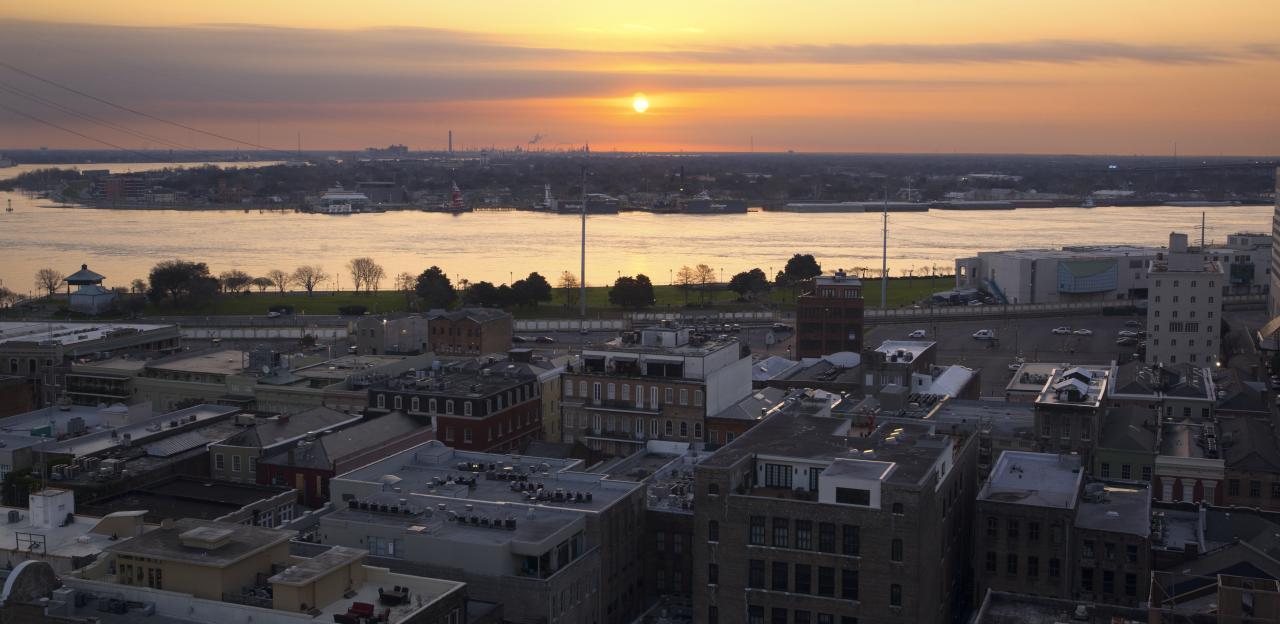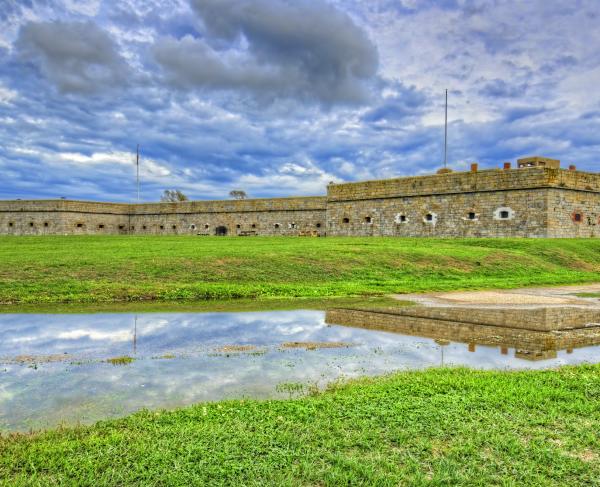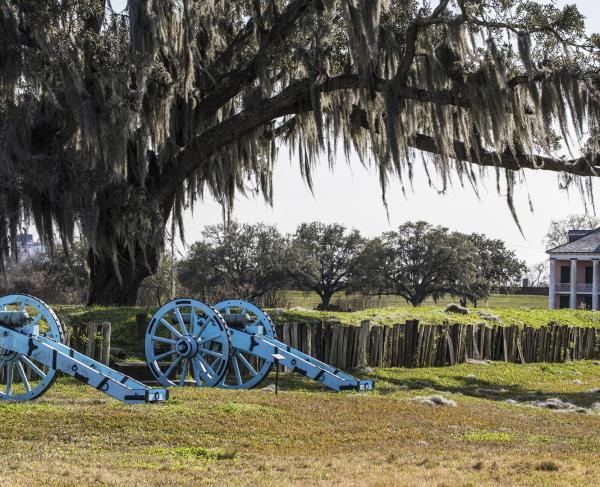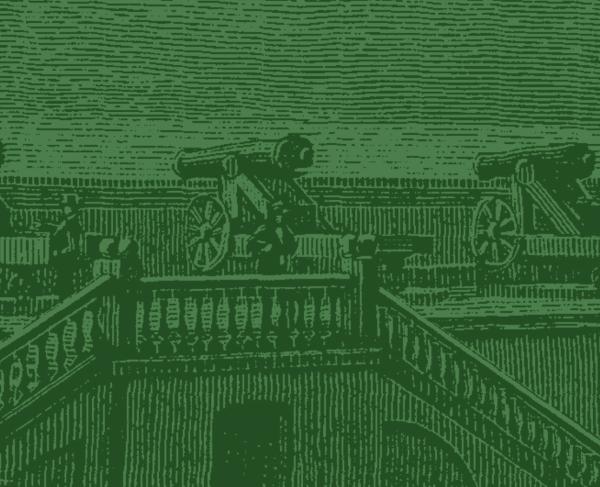Tour New Orleans and Vicinity in Three Days

While known for its eclectic culture, amazing food, and all around nightlife, New Orleans is also host to a variety of historic sites that touch on the Revolutionary War, the War of 1812 and the Civil War.
Before you go:
- Print or Download this Tour Map
- Take a virtual trip to the city
- Learn more about the Battle of New Orleans
- Learn more about the Siege of Port Hudson
- Learn about the pirate turned patriot Jean Lafitte
Stop #1: Confederate Memorial Hall Museum
Time: 1 hour
Details: http://confederatemuseum.com/
The Confederate Memorial Hall Museum houses the second largest collection of Confederate memorabilia in the country and serves as Louisiana’s Civil War Museum.
What to do:
- Check out the personal artifacts of many Confederate generals and politicians and explore the exhibits highlighting the daily lives of Confederate soldiers.
- View the large collection of Civil War era weaponry including a large riled cannon.
Insider tip: For lunch or dinner try Ugly Dog Saloon and BBQ, Sac-a-Lait, or Annunciation
Stop #2: The Cabildo
Time: 1 hour
Details: https://louisianastatemuseum.org/museum/cabildo
Located in the heart of the French Quarter in Jackson Square, the Cabildo is an historic Spanish Colonial building that operates as a museum highlighting the history of New Orleans.
What to do:
- Explore the exhibits “Recovered Memories: Spain, New Orleans, and the Support for the American Revolution,” “From "Dirty Shirts" to Buccaneers: the Battle of New Orleans in American Culture.”
Insider Tip: For lunch, dinner or a quick snack try Cafe du Monde for world famous beignets, Gumbo Shop, or Tableau
Stop #3: Jean Lafitte National Historic Park and Preserve
Time: 1.5 hours
Details: https://www.nps.gov/jela/index.htm
With six sites all over Southern Louisiana, including a visitor center in the French Quarter, Jean Lafitte National Historic Park and Preserve encompasses a variety of Southern Louisianan history and culture while also interpreting its vast natural resources.
What to do:
- Visit the visitor center in the French Quarter and hear a ranger talk and explore the exhibits focused on Louisiana history.
Stop #4: Chalmette Battlefield
Time: 3 hours
Details: https://www.nps.gov/jela/learn/historyculture/places-chalmette-battlefield.htm
As part of the Jean Lafitte National Historic Site and Preserve, the Chalmette Battlefield preserves and interprets the site of the 1815 Battle of New Orleans.
What to do:
- Attend a ranger talk to hear more about the battle.
- Walk the self-guided trails to explore more of the battlefield.
- Be sure to stop by the site visitor center to view exhibits on the War of 1812.
- Stop by the Chalmette National Cemetery and pay respect to the fallen soldiers buried there.
- Visit the Chalmette Monument, a 100-foot-high obelisk that honors the troops of the Battle of New Orleans. Visitors can climb 122 steps to a viewing platform, which gives great views of the battlefield.
- Take the Creole Queen riverboat cruise to for a unique travel experience from the French Quarter to the Chalmette Battlefield.
Insider Tip: For lunch or dinner try Brewster’s Restaurant, or MeMe's Bar and Grille
Stop #5: Ansel M. Stroud Jr. Military History & Weapons Museum (Jackson Barracks)
Time: 1 hour
Details: https://geauxguardmuseums.com/
Built as military barracks during the Jackson administration, the Jackson Barracks served as a Union hospital following the fall of New Orleans and now houses the Ansel M. Stroud Jr. Military History & Weapons Museum which tells the story of Louisianan civilian soldiers from the colonial era into the present day.
What to do:
- Explore the exhibits which house artifacts from the War of 1812 and the Civil War
Stop #6: Metairie Cemetery
Time: 30 minutes
Details: https://www.findagrave.com/cemetery/68207/metairie-cemetery
Metairie Cemetery is in the northern part of New Orleans and serves as the final resting place of many famous southerners, including P.T.G. Beauregard and John Bell Hood.
What to do:
- Visit the graves of the southerners buried there.
- View the cemeteries many monuments, including one dedicated to the Army of Tennessee.
Insider Tip: For lunch of dinner try Biscuits and Buns on Banks, Ralph's on the Park, or Cafe Navarre
Stop #7: Whitney Plantation
Time: 3 hours (not including travel time)
Details: http://whitneyplantation.com/visit.html
Located about an hour outside New Orleans the Whitney Plantation serves as one of the few plantation museums dedicated to interpreting the lives of enslaves peoples and highlights the brutalities and horrors indicative of United States plantation slavery.
What to do:
- Peruse through the exhibits at the visitor center museum.
- Attend the guided tour through the Big House, the outbuildings, the slave quarters and the grounds.
- Visit the Field of Angels, a memorial dedicated to the 2,200 enslaved Louisianan children who never reached their third birthday.
- View the Wall of Honor, a monument dedicated to all the slaves that served on the Whitney Plantation. To restore humanity in a system that dehumanizes individuals, each enslaved person’s name and any recorded information about them is engraved on the monument.
- Explore Allées Gwendolyn Midlo Hall, which is a powerful memorial to honor the 107,000 known enslaved people of Louisiana.
- Visit the Antioch Baptist Church, a post-war structure that represents resistance to systems of white supremacy in the New South. Inside the Church is a series of sculptures called Children of the Whitney, which represent the emancipated enslaved children who’s oral histories were recorded in the mid twentieth century.
Insider Tip: For lunch or dinner try Nobile's Restaurant, or Jenny's Overstuffed Po' Boys
Stop #8: Port Hudson State Historic Site
Time: 4 hours (not including travel time)
Details: https://www.lastateparks.com/historic-sites/port-hudson-state-historic-site
Located a little over an hour and a half a way from New Orleans and an hour away from the Whiney Plantation, in Jackson, Louisiana, the Port Hudson State Historic Site preserves and interprets over 800 acres of land that served as the site of the Port Hudson siege in 1863.
What to do:
- Go on one of the guided tours (be sure to call in advance.)
- Explore the museum with Civil War artifacts from the engagements at Port Hudson.
- Walk one of the many walking trails and view Confederate earthworks.
- Visit the Port Hudson National Cemetery
Stop #9: Beauvoir, Jefferson Davis Home and Presidential Library
Time: 3 hours (not including travel time)
Details: http://www.visitbeauvoir.org/
Located in Biloxi, Mississippi with beautiful views of the Mississippi Sound, Beauvoir served as Jefferson Davis post-war home. Following his death, Beauvoir served as a Confederate Veterans home and eventually became a shrine to Jefferson Davis per his widows wishes.
What to do:
- Tour the historic house.
- Visit the museum and view the Jefferson Davis artifacts.
- Explore the Memorial Cemetery on the property which served as the final resting place. for many Confederate veterans who died in the home.
Insider Tip: For lunch or dinner try The Reef, or The Bootleggers Pizzeria.
Don't Miss
The National World War II Museum
Details: https://www.nationalww2museum.org/
While the subject falls outside of our three wars, the National World War II Museum is the #1 tourist destination in New Orleans and a world-class facility. Learn everything about the American experience in World War II, from the homefront to the roads to Tokyo and Berlin. This captivating and breathtaking museum is a can't miss!
We're launching interpretation of African American history at 7 key battlefields, located in 5 states, spanning 3 wars.
Related Battles
62
2,034
5,000
7,208




